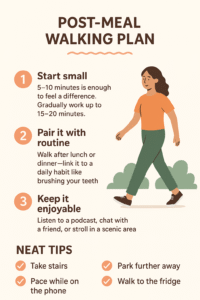We’ve all heard the classic advice: “Take a walk after eating.” Maybe your grandma said it, or perhaps a friend recommended it as a way to aid digestion. But beyond being a simple habit, walking after meals can be a metabolism game-changer, and it’s easier to incorporate into daily life than you might think. Let’s explore why those short post-meal strolls pack such a punch and how they fit into the bigger picture of NEAT—Non-Exercise Activity Thermogenesis.
The Science Behind Post-Meal Walking
When you eat, your body begins a complex process called digestion, which requires energy. Glucose from the food enters your bloodstream, and insulin is released to help shuttle it into cells. But if you remain sedentary immediately after eating, your body has to deal with spikes in blood sugar and insulin, which, over time, can contribute to metabolic issues like insulin resistance.
Enter walking. Just a gentle 10–20 minute walk after meals helps your muscles use some of that glucose for energy. This leads to:
-
Lower postprandial blood sugar spikes – keeping your insulin response balanced.
-
Improved fat metabolism – your body burns more calories at rest over time.
-
Enhanced digestion – reducing bloating, heartburn, and constipation.
Studies have shown that even short bouts of movement after eating—not intense exercise, just a leisurely walk—can have measurable benefits for glucose control, especially in people with prediabetes or type 2 diabetes.
The Power of Short Walks: Less is More
You don’t need to power-walk for an hour to see results. Research consistently shows that 10–15 minutes is sufficient to improve metabolic markers. In fact, breaking up longer periods of sitting with short walks can be more effective than one long workout at the end of the day.
Here’s why short walks are so effective:
-
Immediate glucose regulation: Your muscles start using glucose almost instantly.
-
Gentle on joints: Unlike running or high-impact exercise, walking is low-stress and sustainable.
-
Mental clarity: A walk helps reduce stress hormones like cortisol, which in excess can impair metabolism.
Even after a heavier meal, a slow walk around the block or a few laps inside your home can make a significant difference. It’s not about intensity; it’s about consistency.

NEAT: The Unsung Hero of Metabolism
You may have heard of NEAT—Non-Exercise Activity Thermogenesis. This refers to all the calories your body burns outside of formal workouts: walking to the fridge, fidgeting, cleaning, gardening, or pacing while on a phone call.
NEAT can vary dramatically between individuals—sometimes up to 2,000 calories per day difference! And here’s the exciting part: walking after meals directly contributes to NEAT, because it’s small, sustainable activity added to your daily routine. Over weeks and months, these short bursts of movement can:
-
Boost overall daily calorie expenditure
-
Improve insulin sensitivity
-
Support healthy weight maintenance
By incorporating even minimal movement post-meals, you’re not just aiding digestion—you’re incrementally revving up your metabolism.

Practical Tips to Make Post-Meal Walking a Habit
Making this a consistent habit doesn’t require drastic changes. Here’s how to get started:
-
Start small: 5–10 minutes is enough to feel a difference. Gradually work up to 15–20 minutes.
-
Pair it with routine: Walk after lunch or dinner—link it to a daily habit like brushing your teeth.
-
Keep it enjoyable: Listen to a podcast, chat with a friend, or stroll in a scenic area.
-
Sneak in extra NEAT: Take stairs, pace while talking on the phone, or park further away when shopping.
Remember, it’s about consistency and frequency, not distance or speed. Your body responds to repeated, gentle stimuli over time.
Beyond Metabolism: Holistic Benefits
Walking after meals isn’t just about burning calories. It also supports:
-
Mood regulation: Movement releases endorphins, reducing stress and improving emotional well-being.
-
Heart health: Regular walking helps lower blood pressure and improve circulation.
-
Gut motility: Helps food move smoothly through your digestive tract, reducing bloating and discomfort.
It’s a holistic, simple lifestyle tweak with surprisingly profound effects.
Bottom Line
A short walk after meals is more than just a gentle tradition—it’s a metabolic strategy. By incorporating light movement into your routine, you regulate blood sugar, enhance fat metabolism, and increase daily calorie burn through NEAT. Over time, these small actions compound, supporting overall health and longevity.
So the next time you finish a meal, instead of collapsing on the couch, try stepping outside or pacing around your home. Your metabolism—and your body—will thank you.

